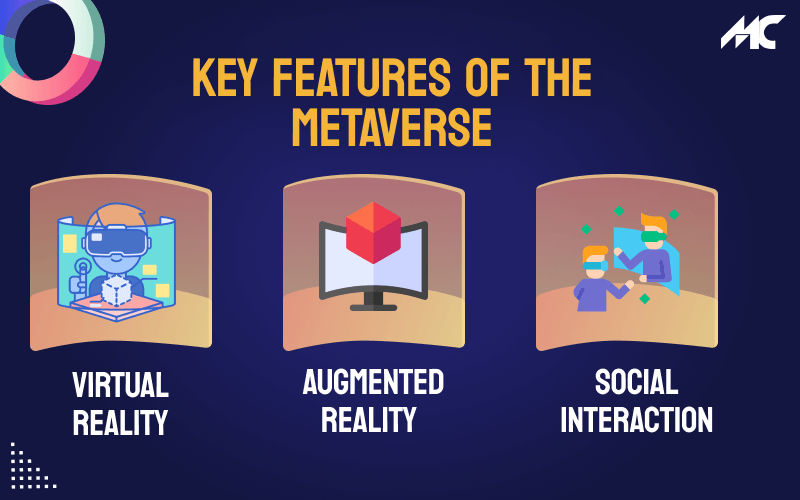In recent years, the concept of the Metaverse has gained immense popularity, especially with the emergence of new technologies and applications that allow people to experience a virtual world that is interactive and immersive. As this technology continues to evolve, it is now being considered as a new learning paradigm that can revolutionize education. Metaverse app development companies are playing a critical role in making this a reality, as they are creating platforms that enable educators and students to engage with one another in a virtual environment.
With the Metaverse, learners can explore a wide range of subjects in a more engaging and interactive way, using avatars to represent themselves and interact with their surroundings. Metaverse app development company are creating applications that are not only fun and engaging but also help students learn more effectively by providing them with new ways to explore and understand complex concepts.
Key Features Of The Metaverse
The metaverse is a virtual reality universe that offers users a variety of features, including:
1. Virtual Reality
Virtual reality (VR) is a technology that allows users to immerse themselves in a computer-generated environment. VR technology creates a sense of presence, where the user feels like they are actually in the virtual world. In education, VR can be used to simulate real-life scenarios that are difficult to recreate in a traditional classroom. For example, students can take a virtual field trip to a historical site or a science lab, or they can practice complex procedures in a safe and controlled environment.
2. Augmented Reality
Augmented reality (AR) is a technology that overlays digital information onto the real world. AR can be used in education to enhance learning experiences by adding digital information to real-life objects. For example, students can use AR to scan a textbook and get additional information or 3D models that illustrate complex concepts. AR can also be used to create interactive quizzes or scavenger hunts, where students have to find and scan different objects to complete the task.
3. Social Interaction
Social interaction is a key feature of the metaverse. In a virtual space, users can interact with each other in real-time, regardless of their physical location. This can create opportunities for collaborative learning, where students can work together on projects, discuss ideas, or simply socialize. Social interaction can also be used to create immersive storytelling experiences, where students can role-play as characters in a story or historical event.
Challenges and Opportunities
Despite the many opportunities that the metaverse offers for education, there are also challenges to overcome. One of the primary challenges is the cost of hardware and software required to access the metaverse. Another challenge is ensuring the security and privacy of students in the virtual environment. However, the opportunities outweigh the challenges. For example, the metaverse can provide access to education for people who may not have access to traditional education. It can also offer a more personalized learning experience and enable collaboration between students and teachers from all over the world.
Despite these challenges, the metaverse also presents many opportunities. It can offer new ways of learning that are engaging, interactive, and immersive. The metaverse can also provide opportunities for personalized learning, where students can learn at their own pace and in their own style. Additionally, the metaverse can connect students from different parts of the world, creating a global community of learners.
Also Read: The Role of VR in the Metaverse?
Implications For The Future Of Education
The metaverse has the potential to transform the way we approach education. It can provide a more personalized learning experience that is tailored to the needs and interests of individual students. It can also provide a more inclusive learning environment, allowing students with different learning styles and abilities to excel.
In addition, the metaverse can help to prepare students for the future of work. As more jobs become automated, the skills that will be in demand are those that cannot be easily replicated by machines, such as creativity, critical thinking, and problem-solving. The metaverse can help to develop these skills by providing a platform for students to experiment, collaborate, and innovate.
Conclusion
The metaverse is a new frontier in education, offering a range of opportunities and challenges. Metaverse app development companies are leading the way in creating platforms and applications that enable students to explore complex concepts in immersive and interactive virtual environments. As the technology becomes more accessible and affordable, the metaverse has the potential to transform the way we learn and prepare for the future.
FAQ:
Q: What is the metaverse?
A: The metaverse is a virtual reality universe where people interact with each other through avatars.
Q: What are the key features of the metaverse?
A: The key features of the metaverse include virtual reality, augmented reality, and social interaction.
Q: What are the challenges of using the metaverse in education
A: The challenges of using the metaverse in education include the cost and availability of technology and the need for specialized skills and knowledge to develop metaverse applications.
Q: What are the opportunities of using the metaverse in education?
A: The opportunities of using the metaverse in education include a more engaging and interactive learning experience, a more inclusive learning environment, and the development of skills that are in demand in the future of work.


